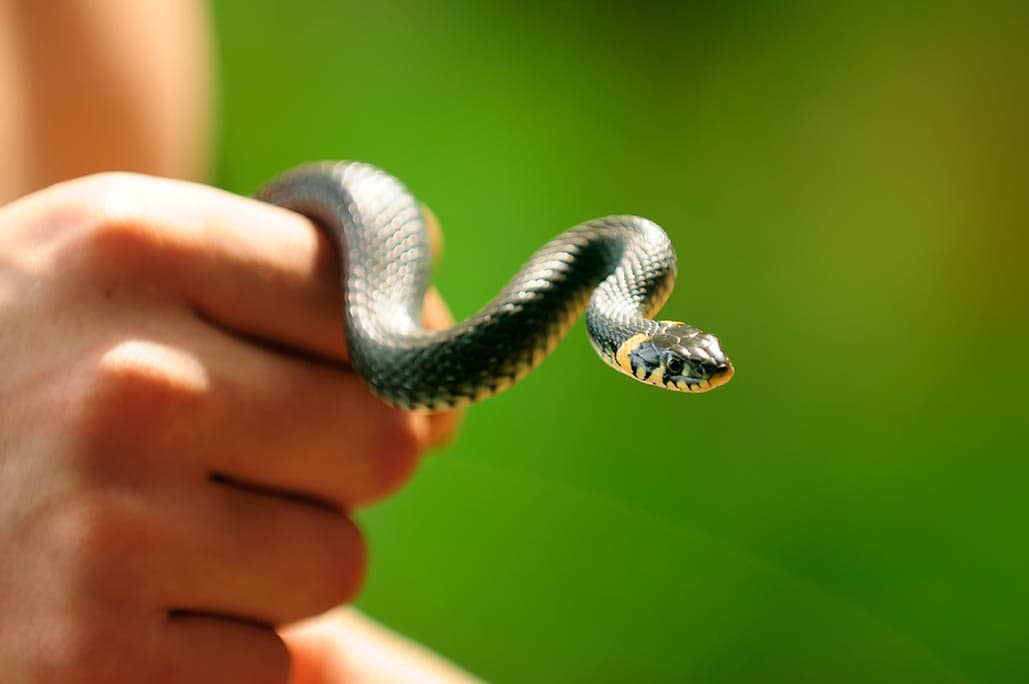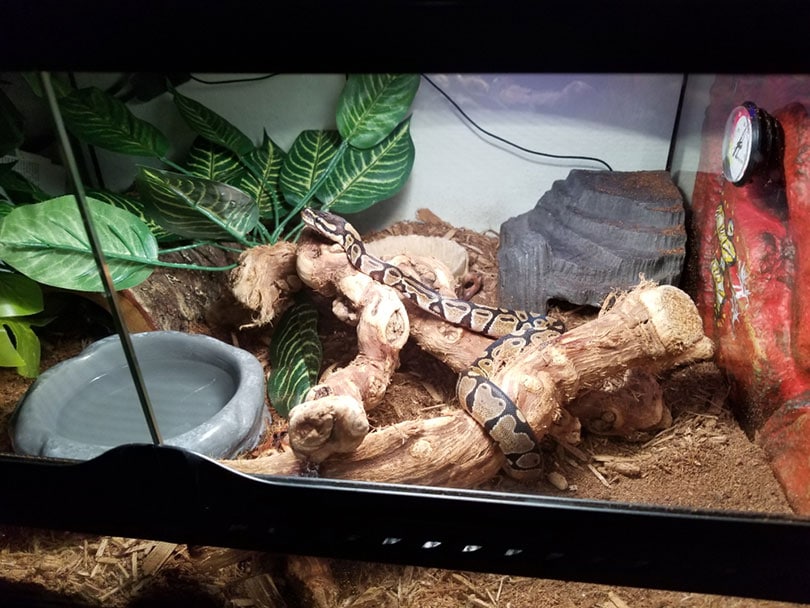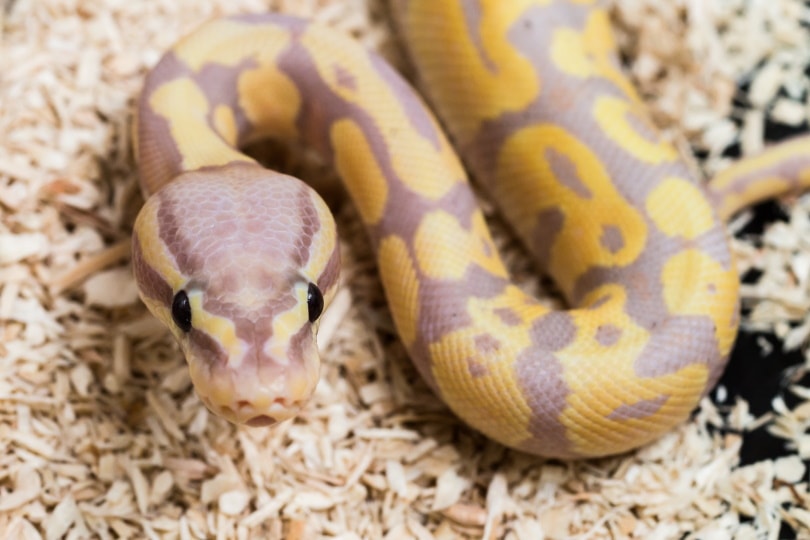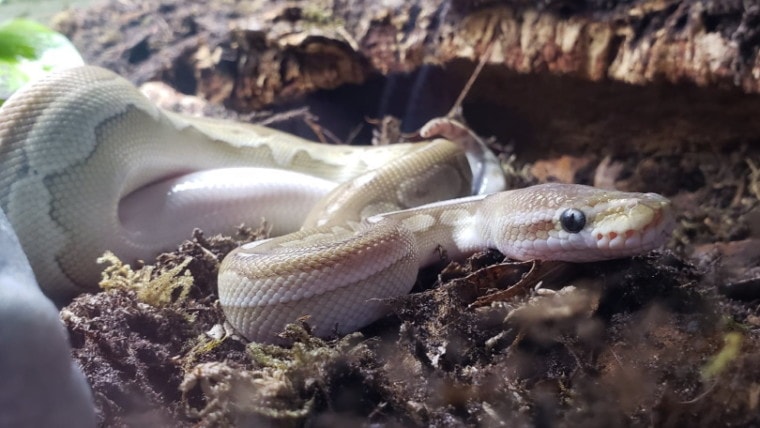
Ball pythons make great pet snakes for reptile keepers with experience in snakes. They are engaging and curious snakes that will form a lifelong bond with their owner. The cinnamon ball python morph is an exceptionally beautiful snake with interesting colors and patterns. They are relatively easy to care for and to keep healthy in captivity. They are undemanding and easy to handle. The cinnamon morph is co-dominant and that was created in 2002. This color morph quickly became idolized in the reptile community and people were quick to fall in love with not only the coloration but the snake’s personality, too.
Quick Facts about The Cinnamon Ball Python Morph
| Species Name | Python regius |
| Common Name | Ball python |
| Care Level | Intermediate |
| Lifespan | Up to 30 years |
| Adult Size | 4 to 5 feet long |
| Diet | Carnivore |
| Minimum Tank Size | 40-gallons |
| Temperature & Humidity | Hot end: 90°F to 95°F Cold end: 70°F to 80°F Humidity: 50% to 60% |
Do Cinnamon Ball Pythons Make Good Pets?

Yes! They are one of the easier snakes to provide for in the hobby. However, a certain skill level is required to keep these snakes thriving. Ball pythons grow quite large and live for an exceptionally long time. This means they will be in your care for nearly three decades. They make excellent pet snakes if their needs are met, and you will be rewarded with a loving scaled companion. The maintained and feeding schedule may take a few hours out of your day to tend to. You need to be prepared to care for the snake appropriately and feed it the correct diet according to its age.
Appearance
The cinnamon ball python morph has an intricate dark brown pattern with lighter tones throughout the underside of the body which is unmarked. Ball pythons can get quite big, and the adult size of an average ball python is between 4 to 5 feet. They grow longer than many other species of pet snakes which is why they require a large enclosure. The lighter pattern on the cinnamon morph is distinctive and varies between light and dark brown. A ball python’s body is 2 to 3 inches thick, and an adult snake can weigh between 3 to 6 pounds.
- See also: Are Snakes Intelligent?
 How to Take Care of Cinnamon Ball Pythons
How to Take Care of Cinnamon Ball Pythons
Habitat, Tank Conditions & Setup
Tank
Ball pythons should be in a tank or terrarium of 40 gallons at a minimum. Young snakes can be in a tank or Rubbermaid tub of 20 gallons. The lid should be adjusted as it makes the humidity hard to control in the habitat. Meshed lids do not retain heat and moisture well which can cause issues with the health of your ball python. The habitat will need to be cleaned and sanitized regularly to prevent the build-up of bacteria. This will include washing and rinsing the water bowl and changing the substrate.
Lighting
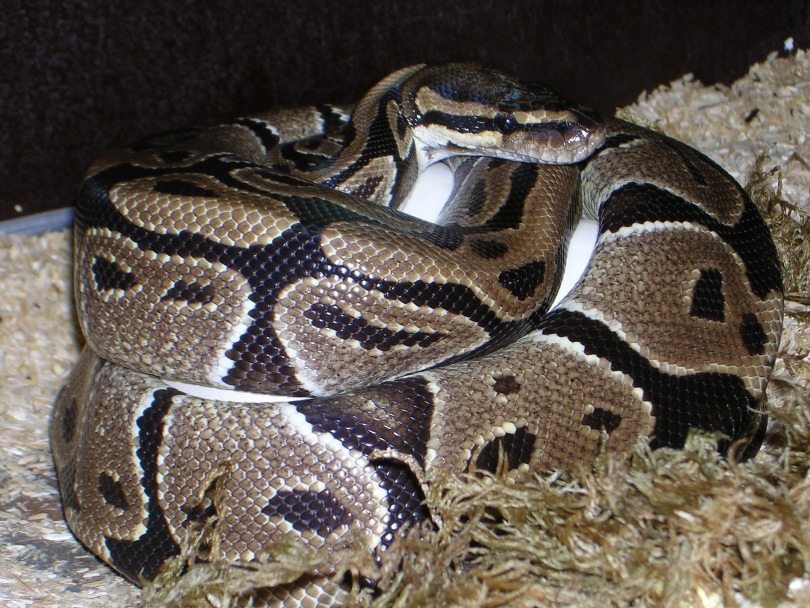
Ball pythons require a basking spotlight that should also provide your snake with a day and night cycle. Most lights come with a timer so that they can automatically turn on and off at the appropriate times.
Heating (Temperature & Humidity)
The enclosure should have an appropriate thermal gradient so that your ball python can utilize the right temperatures. The habitat should be monitored with a digital thermometer. A cool and warm side is essential to maintain in the habitat. The basking spot should be between 90°F to 95°F and the cool side of the habitat should be 75°F to 80°F. The humidity in the enclosure should be kept strictly between 50% to 60%.
Substrate
Cypress mulch and orchid bard are ideal substrates for ball pythons. These substrates hold moisture and humidity well. Shavings and peat bedding should be avoided with ball pythons. Cedar and pine wood shavings contain oils and phenols that are deadly to reptiles.
| Tank Recommendations | |
| Tank Type | 40-gallon glass tank/terrarium |
| Lighting | Heating |
| Heating | Basking lamp |
| Best Substrate | Cypress mulch or orchid bark |
Feeding Your Cinnamon Ball Python
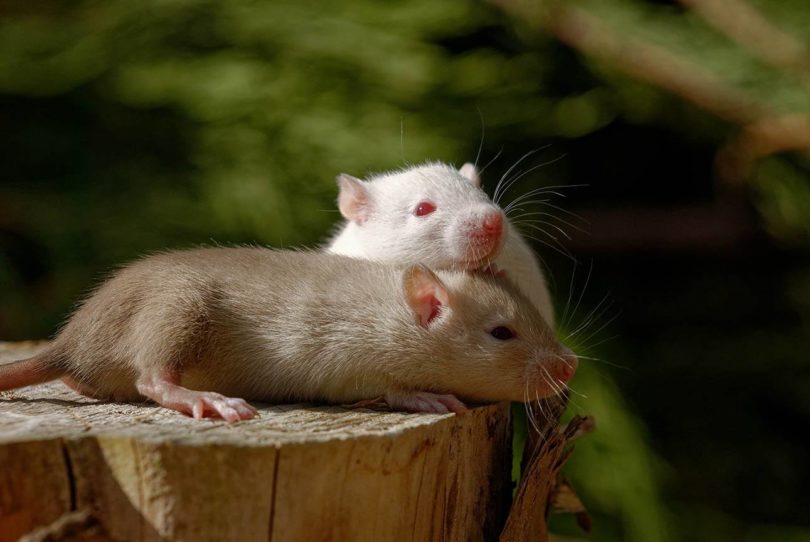
Ball pythons should be fed a rodent weekly to satiate their appetite. The size of the rodent is important, and the prey should be no larger than the circumference size of the ball python. Rats are an ideal food source for these snakes and can be fed to them from an early age. Pinkies (baby rats) are a good size for young ball pythons. Avoid holding your ball python for the next 24 hours of its eats as this can promote regurgitation. Live prey could potentially harm the snake and they should not be left unattended during mealtime. Frozen food should be thawed the night before feeding. Ball pythons will naturally lose their appetite during the winter months and may skip meals during this time.
Freshwater should be always available for your ball python, and a shallow reptile dish is best.
| Diet Summary | |
| Fruits | 0% of the diet |
| Insects | 0% of the diet |
| Meat | 100% of diet – small/medium-sized rodents |
| Supplements Required | N/A |
Keeping Your Cinnamon Ball Python Healthy
It is simple to keep your ball python healthy. Make sure that you provide them with a spacious habitat with lots of enrichment and shelters in the form of plants, caves, or reptile hideouts. The temperature and humidity should never fluctuate. Too much or too little humidity can have adverse effects on their health. A humidity gauge comes in handy and will give you an accurate reading of the humidity range in the habitat. Your snake may also require a reptile veterinarian if they develop an illness or seem poorly.
Common Health Issues

Lifespan
Ball pythons can live for a long time. A healthy and well-cared-for ball python can live between 20 to 30 years. It is not uncommon for them to reach the 40- or 50-year mark in captivity. Some of the oldest ball pythons on record are 60 years old.
Breeding
The breeding pair of ball pythons should be sexually mature, which will generally be around two years of age. The males can be bred young, but the females should at least weigh 1500 grams and be over two years of age when they are bred. They have a constant reproductive life and the breeding season occurs around September to November. Ball pythons lay eggs and they should be incubated using the proper equipment. The females will lay a clutch of four to six eggs, although some do not hatch if the temperature in the incubator is irregular.
Are Ball Pythons Friendly? Our Handling Advice

Ball pythons have a shy nature and will spend most of their time under the basking light or sleeping under a plant or hideout in the habitat. It will initially think that you are a threat and may strike or curl into a defensive ball to protect itself. Handling your ball python from a young age will get them used to you and they will eventually become completely relaxed in your presence. Ball pythons should be handled gently with care. Do not use fast movements or let multiple people hold the snake at once. This will only stress your snake out and cause them to hide more.
Shedding & Brumation: What to Expect
Ball pythons shed their skin regularly as they grow. They reply on humidity at this time and the moisture in the enclosure should be increased. You may need to place the snake in a dish of shallow warm water if they develop a stuck shed. They will shed every four to six weeks and the scales will loosen. It is not uncommon for the eyes to develop a blue or milky hue. Ball pythons do not brumate but will lose their appetite and sleep for longer during the winter months.
How Much Do Cinnamon Ball Pythons Cost?
The cinnamon ball python morph will usually be sold between $50 to $100. The price depends on where you purchase the snake from as breeders will usually charge more. Although this is beneficial because the snake will have a better genetic potential. You can also buy ball python eggs and incubate them yourself. Which will cost between $20 to $60.
Care Guide Summary
•Can Cockatiels Eat Spinach? What You Need to Know!
 Final Thoughts
Final Thoughts
Cinnamon ball pythons can add an exotic and joyful reptile-keeping experience for many owners. Their timid and gentle nature makes them easy snakes to raise and care for properly. Your ball python will live with you for the majority of your life and this makes them a great pet for those who want a reptile that will be under their care for a while.
Featured Image Credit: Nathan Sebranek, Shutterstock


 How to Take Care of Cinnamon Ball Pythons
How to Take Care of Cinnamon Ball Pythons
